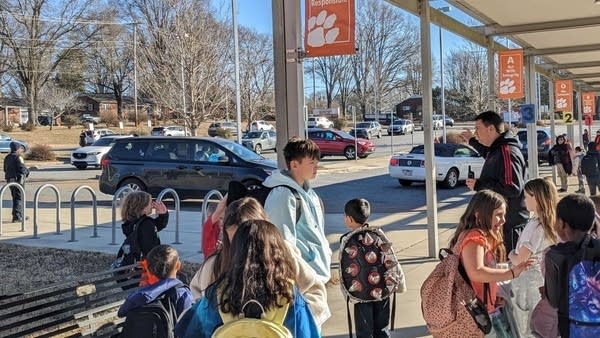
About an hour outside of Charlotte, North Carolina, construction is underway for a brand-new Newton-Conover High School. Superintendent Aron Gabriel said it will serve both small towns, which are just off the interstate in rural area.
Gabriel is optimistic that the new building, with its spacious classrooms and new athletic facilities, will attract new students. In the five years it took to plan and build this school, student enrollment in this small district has dropped 11%.
“We’ve just got to figure out how to get people to follow, and then more people to have babies and bring them here,” Gabriel said.
Now a school that was meant to prevent overcrowding isn’t likely to be crowded.

Gabriel doesn’t know why. There are no competing charter schools, and it’s not like the town recently lost a factory. But fewer kids keep showing up for kindergarten.
“I’m still scratching my head, but I can’t control it,” Gabriel said.
Public school enrollment peaked in the United States in 2019 and has been falling at many school districts across the country ever since. When the pandemic hit, some families flocked to homeschooling or private schools. Some wanted to avoid catching COVID, while others wanted to avoid masking or remote learning. Whatever their reasons, five years later, public schools still have fewer students than they did before the pandemic.
But school choice isn’t the only reason why. Larger demographic trends are also changing the economics at public schools, especially in small towns.
Gabriel receives annual enrollment projections from the state that tell him how many students to expect each fall, but they’re based on historical trends and are not a crystal ball.

Researchers at Carolina Demography at University of North Carolina, Chapel Hill, calculate those projections. The center’s director, Nathan Dollar, hasn’t analyzed what’s happening in Newton-Conover specifically, but he said there are three factors causing enrollment decline across the state.
“No. 1 is births. You have market share. And then you have migration,” Dollar explained.
For any school district, you have to look at all three, starting with births, he said. “Fertility is on the decline everywhere.”
The birth rate in North Carolina and the country has been falling for almost 20 years, then it took a nosedive with the pandemic. As far as migration, North Carolina has been gaining residents from other states, but they’re not coming in droves to rural places like Newton.
“Most of the people that are moving to North Carolina are moving to our urban centers, and they’re in those prime working ages … so they’re the most likely to have children,” Dollar said.
Then the last factor is what Dollar calls “market share” — people leaving a particular school district for homeschooling, charter schools or private schools.
All three of these forms of schooling are on the rise in the state. The problem for school districts like Newton-Conover is that all these forces are hitting them at once, affecting their bottom line.
At the end of his day, Gabriel stops by South Newton Elementary, a school that has been losing students.
“The way our funding flows is per kid, and as the per-kid numbers go down, so does our funding,” Gabriel said.
Most of that funding goes to pay educators. Gabriel hasn’t yet let go of teachers, but he has cut about half of the district’s administrative positions in the last five years. That means some staff — including Chief Academic Officer Tammy Brown — now do the work of several people.
Gabriel bumps into Brown while she is helping students in the car pickup line. The two of them have known each other since elementary school.
Said Gabriel: “She was in first grade when I was in kindergarten, so we’ve known each other —”
“Forever!” Brown pipes up, finishing Gabriel’s sentence.

Gabriel explains that Brown has recently taken on management of federal programs and English as a second language services, joking that she does 50 jobs now.
“About that,” Brown replied.
“And if she stands here long enough, I’ll give her another one,” Gabriel said with a chuckle.
They’re joking, but Gabriel is visiting the school this particular afternoon to meet with staff about more possible cuts. He said he can’t name any positions yet, because if he did, everyone in town would know who’s at risk of losing their job.
As the district cuts staff who manage programs that serve the most vulnerable kids, Gabriel is worried it will affect the students who are still here.
“You worry — am I going to be able to provide the same level of service?” Gabriel said.
Big picture, Gabriel said: Drops in enrollment lead to cuts, and that impacts the kids — especially the ones who need the most support.










